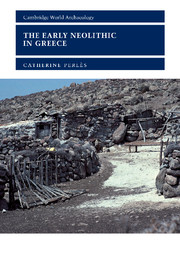Book contents
- Frontmatter
- Contents
- List of figures
- List of tables
- Acknowledgements
- Introduction
- 1 The land and its resources: the geographic context
- 2 The Mesolithic background
- 3 The introduction of farming: local processes, diffusion or colonization?
- 4 Foreign colonists: where from?
- 5 The earliest Neolithic deposits: ‘aceramic’, ‘pre-pottery’ or ‘ceramic’?
- 6 The spread of the Early Neolithic in Greece: chronological and geographical aspects
- 7 A case study in Early Neolithic settlement patterns: eastern Thessaly
- 8 Early Neolithic subsistence economy: the domestic and the wild
- 9 The Early Neolithic village
- 10 Craft specialization: the contrasting cases of chipped-stone tools, pottery and ornaments
- 11 A variety of daily crafts
- 12 Ritual interaction? The miniature world of ‘dolls or deities’
- 13 Interacting with the dead: from the disposal of the body to funerary rituals
- 14 Interactions among the living
- Conclusion
- Bibliography
- Index
5 - The earliest Neolithic deposits: ‘aceramic’, ‘pre-pottery’ or ‘ceramic’?
Published online by Cambridge University Press: 18 December 2009
- Frontmatter
- Contents
- List of figures
- List of tables
- Acknowledgements
- Introduction
- 1 The land and its resources: the geographic context
- 2 The Mesolithic background
- 3 The introduction of farming: local processes, diffusion or colonization?
- 4 Foreign colonists: where from?
- 5 The earliest Neolithic deposits: ‘aceramic’, ‘pre-pottery’ or ‘ceramic’?
- 6 The spread of the Early Neolithic in Greece: chronological and geographical aspects
- 7 A case study in Early Neolithic settlement patterns: eastern Thessaly
- 8 Early Neolithic subsistence economy: the domestic and the wild
- 9 The Early Neolithic village
- 10 Craft specialization: the contrasting cases of chipped-stone tools, pottery and ornaments
- 11 A variety of daily crafts
- 12 Ritual interaction? The miniature world of ‘dolls or deities’
- 13 Interacting with the dead: from the disposal of the body to funerary rituals
- 14 Interactions among the living
- Conclusion
- Bibliography
- Index
Summary
A biased debate
The status of the earliest Neolithic in Greece is still a matter of debate. Is it, as first suggested by Milojčić, an ‘Aceramic’, or ‘Preceramic’ Neolithic? Is it, as claimed by many, a fully ceramic Early Neolithic? Or could it represent a discrete ‘ceramic’ phase that this simple dichotomy has thus far obscured?
Milojčić was the first to suggest that a ‘Preceramic’ Neolithic may have existed in Europe, as it did in the Near East (Milojčić 1952). His subsequent excavations at Argissa in Thessaly seemingly brought the confirmation he sought: the basal levels were conspicuously poorer in sherds than the overlying ceramic Neolithic levels (Milojčić 1955, 1956, 1959b, 1960; Milojčić et al. 1962). Soon after, Evans published the preliminary results of his excavations at Knossos, where he too recognized ‘aceramic’ levels at the base of a long Neolithic sequence (Evans 1964). Meanwhile, Theocharis had undertaken trial excavations at several other Thessalian sites, where he also uncovered levels that he considered ‘Preceramic’ (Sesklo from 1956 on, Soufli in 1958, Achilleion in 1961 and Gediki in 1962). He then published the first synthesis of the ‘Preceramic’ in Greece in his doctoral dissertation ‘The dawn of Thessalian Prehistory’ (Theocharis 1967).
However, as early as 1970, Nandris reviewed the published evidence and firmly concluded, ‘It is now clear that the Greek “PPN” is by no means aceramic’ (Nandris 1970: 193).
- Type
- Chapter
- Information
- The Early Neolithic in GreeceThe First Farming Communities in Europe, pp. 64 - 97Publisher: Cambridge University PressPrint publication year: 2001



